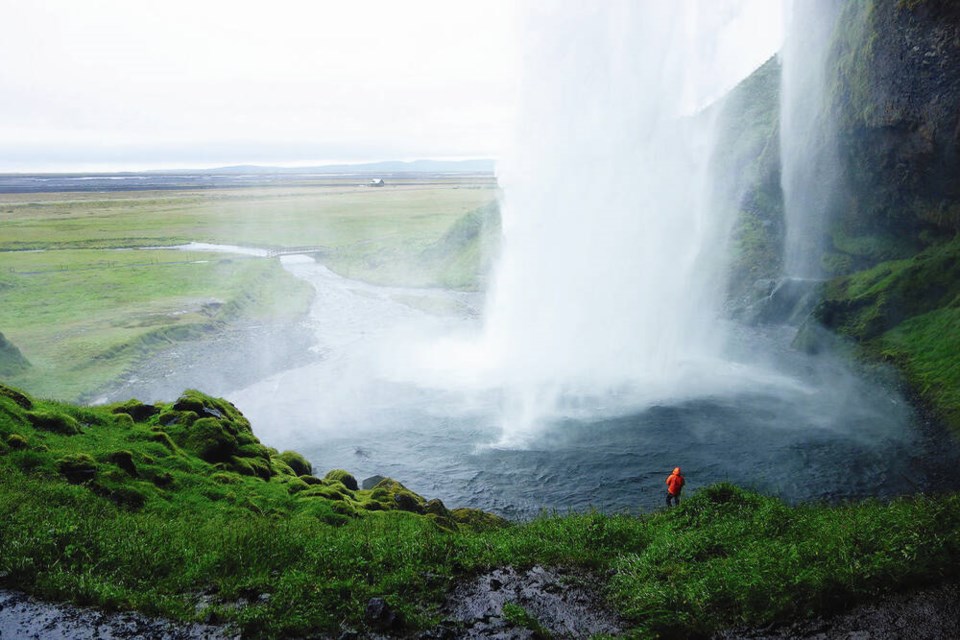Iceland’s remote location and harsh climate aren’t exactly welcoming. But its striking scenery, draped with glaciers and punctuated by craggy peaks and steamy geysers, makes this destination increasingly attractive to nature-loving travellers.
On one of my trips back to the U.S. from Europe, I took advantage of Icelandair’s free stopover and spent several days exploring the island. Besides touring the capital city, Reykjavík — where 60 per cent of Iceland’s 370,000 citizens live — I took time to seek out some more isolated areas. The country’s interior is basically uninhabited, but its perimeter is encircled by an 1,300-kilometre-long Ring Road, also known as Route 1. This road — not completed until 1974 — makes it possible to visit the country’s more remote geological oddities.
With my guide Arnar at the wheel of a sturdy “super Jeep,” I spent a day in volcano country in Thórsmörk (Thor’s Woods), a nature reserve in the southwest surrounded by mountains, rivers, and lagoons. The weather was terrible, but it was still a glorious day as we ventured up a long lava-flow valley in the shadow of Eyjafjallajökull, the famous volcano only Icelanders can call by name. Non-Icelandic speakers are invited to refer to it by its first letter and the number of letters that follow: E15. In our 4x4, Arnar and I climbed crumbly hills, forded rivers and a wet volcanic desert, and eventually parked at the foot of a mighty glacier for a picnic.
The valley landscape has plenty of moss and green scrub covering black volcanic lava flows. Even when the first settlers came to this island — some 800 kilometres from Scotland, its nearest neighbour — Iceland was nearly without trees. Those early immigrants were Vikings, thousands of whom came in the ninth and tenth centuries.
In 930, Icelandic chieftains gathered at what became an annual meeting called the Alþingi (“all-thing”) at a place named Thingvellir, which can be thought of as Iceland’s first capital. Shortly after that, while under extreme pressure from the Norwegian king, Iceland converted to Christianity — so they’ve been churchgoers for a thousand years. Rather than wars, Icelanders weathered centuries of brutal winters — and volcanic eruptions.
These eruptions are a by-product of location. This island — a little smaller than the state of Kentucky — is where the North American and Eurasian tectonic plates meet. The western half of the island, with the capital Reykjavík, is on the North American side, the eastern half of the island is on the Eurasian plate, and the Mid-Atlantic ridge down the middle is a fault with plenty of geological friction.
Living on an island of live volcanoes in the middle of the ocean is not easy. One of the biggest lava flows in recorded history came from the Laki volcano in 1783, and the famine and illness that followed left 20 per cent of Iceland’s population dead. The volcanic ash also impacted weather and crops in Europe for several summers, causing widespread hunger. Some historians say those conditions contributed to the economic unrest that led to the French Revolution at the end of that decade. Though most eruptions aren’t so devastating, Iceland weathers an average of one every five years. The eruption of Eyjafjallajökull was big news in 2010, when it stopped air travel across Europe, inconveniencing many travellers (including me). More recently, in late 2023, an eruption spewed lava near the town of Grindavík, which had been evacuated in advance.
All the geological activity does have its benefits. Geothermal power plants tap into the heat spilling out from deep in the Earth. Across Iceland, you’ll see an infrastructure of pipes and power plants tapping into that natural source of energy. And ever since the advent of thermal-powered greenhouses — which you see glowing in the mist around Iceland — locals no longer have an excuse not to buy fresh flowers for their sweethearts.
With so much geothermal energy, Iceland is a culture of swimming pools and hot tubs. It seems nearly every visitor who can afford the steep entry fee decides to kick off or cap a visit to Iceland with a luxurious soak in the famous Blue Lagoon. This giant spa complex is just 20 minutes from the airport and 45 minutes from the centre of Reykjavík. Floating around in the toasty, milky-blue water surrounded by an undulating landscape obscured by steam, I don’t hear a word of Icelandic — a reminder that this famed spa is the domain of tourists. The locals prefer their simpler neighbourhood thermal pools (for about a tenth the cost).
Whether you’re floating with locals or tourists, with steamy pools amid a bracing North Atlantic wind, grand views, and fascinating history, there’s plenty to make this outdoor-lover’s hotspot worth a stop.
This article is used with the permission of Rick Steves’ Europe. Rick Steves writes European guidebooks, hosts travel shows on public TV and radio, and organizes European tours.



